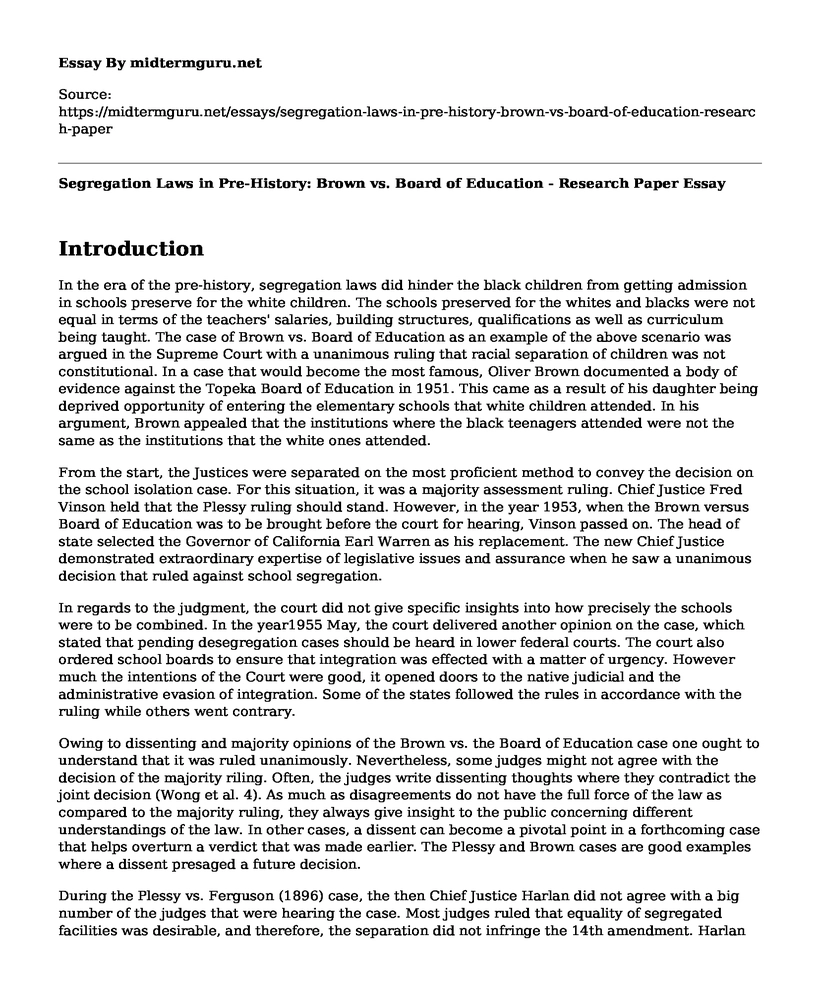Introduction
In the era of the pre-history, segregation laws did hinder the black children from getting admission in schools preserve for the white children. The schools preserved for the whites and blacks were not equal in terms of the teachers' salaries, building structures, qualifications as well as curriculum being taught. The case of Brown vs. Board of Education as an example of the above scenario was argued in the Supreme Court with a unanimous ruling that racial separation of children was not constitutional. In a case that would become the most famous, Oliver Brown documented a body of evidence against the Topeka Board of Education in 1951. This came as a result of his daughter being deprived opportunity of entering the elementary schools that white children attended. In his argument, Brown appealed that the institutions where the black teenagers attended were not the same as the institutions that the white ones attended.
From the start, the Justices were separated on the most proficient method to convey the decision on the school isolation case. For this situation, it was a majority assessment ruling. Chief Justice Fred Vinson held that the Plessy ruling should stand. However, in the year 1953, when the Brown versus Board of Education was to be brought before the court for hearing, Vinson passed on. The head of state selected the Governor of California Earl Warren as his replacement. The new Chief Justice demonstrated extraordinary expertise of legislative issues and assurance when he saw a unanimous decision that ruled against school segregation.
In regards to the judgment, the court did not give specific insights into how precisely the schools were to be combined. In the year1955 May, the court delivered another opinion on the case, which stated that pending desegregation cases should be heard in lower federal courts. The court also ordered school boards to ensure that integration was effected with a matter of urgency. However much the intentions of the Court were good, it opened doors to the native judicial and the administrative evasion of integration. Some of the states followed the rules in accordance with the ruling while others went contrary.
Owing to dissenting and majority opinions of the Brown vs. the Board of Education case one ought to understand that it was ruled unanimously. Nevertheless, some judges might not agree with the decision of the majority riling. Often, the judges write dissenting thoughts where they contradict the joint decision (Wong et al. 4). As much as disagreements do not have the full force of the law as compared to the majority ruling, they always give insight to the public concerning different understandings of the law. In other cases, a dissent can become a pivotal point in a forthcoming case that helps overturn a verdict that was made earlier. The Plessy and Brown cases are good examples where a dissent presaged a future decision.
During the Plessy vs. Ferguson (1896) case, the then Chief Justice Harlan did not agree with a big number of the judges that were hearing the case. Most judges ruled that equality of segregated facilities was desirable, and therefore, the separation did not infringe the 14th amendment. Harlan went ahead to write a dissent that stated that separation went in contrary with the 14th amendment since it made use of the law to authorize discrimination among different races. In the Brown vs. Board of Education (1954) case, Earl Warren likewise proclaimed that different offices disregarded the Constitution. However, he built his contention on a somewhat unique conclusion.
I agree with the court ruling because education is the most vital role of the government. This is an opportunity that the government must provide as a right which must be accessible on similar terms and that race should be factored in when giving education to children.
Works Cited
Wong, Kenneth K., and Anna C. Nicotera. "Brown v. Board of Education and the Coleman Report: Social science research and the debate on educational equality." Peabody Journal of Education 79.2 (2004): 122-135. https://doi.org/10.1207/s15327930pje7902_8
Cite this page
Segregation Laws in Pre-History: Brown vs. Board of Education - Research Paper. (2023, Feb 04). Retrieved from https://midtermguru.com/essays/segregation-laws-in-pre-history-brown-vs-board-of-education-research-paper
If you are the original author of this essay and no longer wish to have it published on the midtermguru.com website, please click below to request its removal:
- Learning a Language in the Environment by the Example of Rodriguez
- Film Analysis Essay on Babies by Thomas Balmes
- Paper Example on Challenges That International Students Experience in the US
- Guidelines for Selecting Toys - Essay Sample
- Do Treatment of Prisoners Matter in Society? - Essay Sample
- Parents: Don't Have Too Many Kids - Avoid Exhaustion & Health Issues - Essay Sample
- Rupert Murdoch: From Billionaire Media Mogul to Scandal-Hit Businessman - Essay Sample







